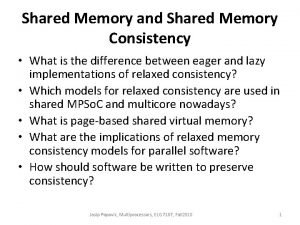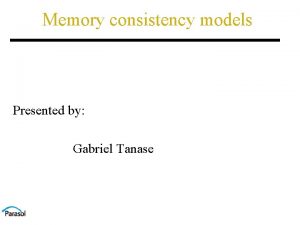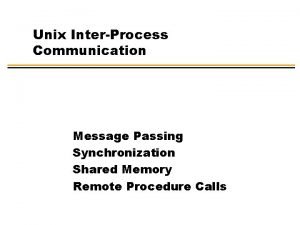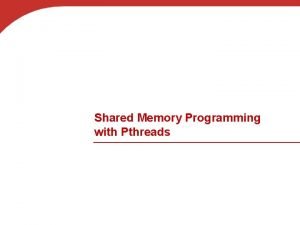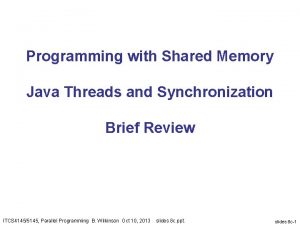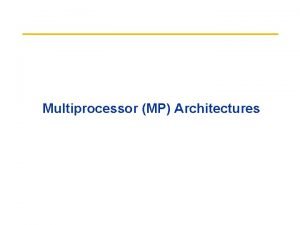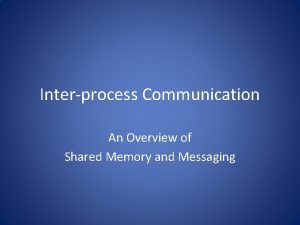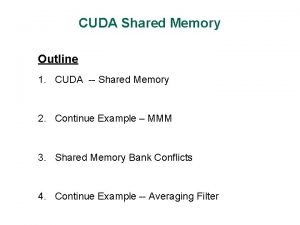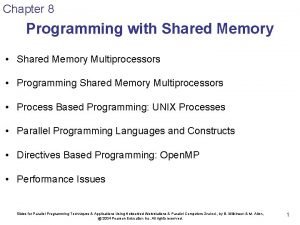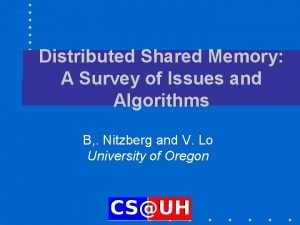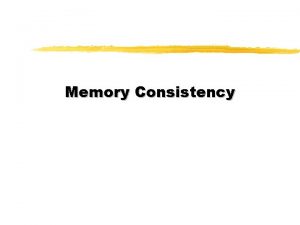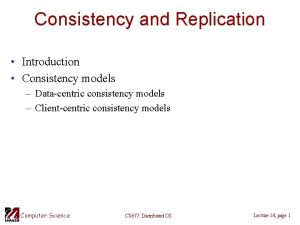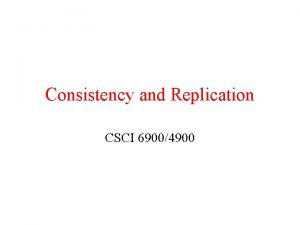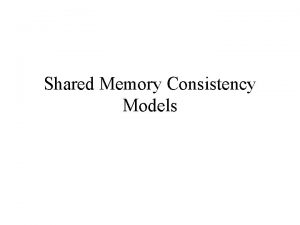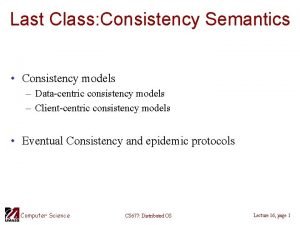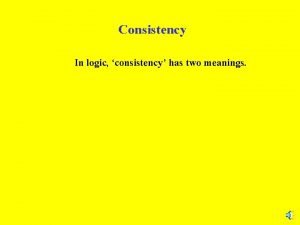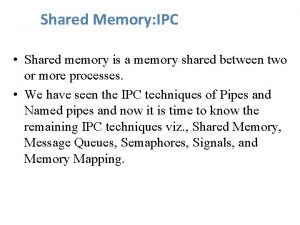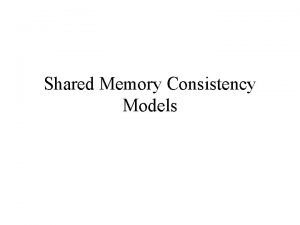Shared Memory Hardware and Memory Consistency Modified from


















- Slides: 18

Shared Memory Hardware and Memory Consistency Modified from J. Demmel and K. Yelick http: //www. cs. berkeley. edu/~demmel/cs 267_Spr 11/ CS 267 Lecture 6 1

Basic Shared Memory Architecture • Processors all connected to a large shared memory • Where are caches? P 1 P 2 Pn interconnect memory • Now take a closer look at structure, costs, limits, programming 02/03/2011 CS 267 Lecture 6 2

Memory Hierarchy • Most programs have a high degree of locality in their accesses • spatial locality: accessing things nearby previous accesses • temporal locality: reusing an item that was previously accessed • Memory hierarchy tries to exploit locality to improve average processor control datapath registers on-chip Second level cache (SRAM) Main memory (DRAM) Secondary storage (Disk) cache Latency 1 ns 100 ns 10 ms Size KB MB GB TB 02/03/2011 3

Caching in Shared Memory Multiprocessors P 1 Pn $ $ Bus Mem I/O devices • Want High performance for shared memory: Use Caches! • Each processor has its own cache (or multiple caches) • Place data from memory into cache • Writeback cache: don’t send all writes over bus to memory • Caches Reduce average latency • Automatic replication closer to processor • More important to multiprocessor than uniprocessor: latencies longer • Normal uniprocessor mechanisms to access data • Loads and Stores form very low-overhead communication primitive • Problem: Cache Coherence! 02/03/2011 Slide source: John Kubiatowicz

Example Cache Coherence Problem P 2 P 1 u=? $ P 3 3 u= ? 4 $ 5 $ u : 5 u= 7 u : 5 1 I/O devices u : 5 2 Memory • Processors could see different values for u after event 3 • How to fix with a bus: Coherence Protocol • Use bus to broadcast writes or invalidations • Bus not scalable beyond about 64 processors (max) • Capacity, bandwidth limitations 02/03/2011 Slide source: John Kubiatowicz

Another example: Cache Coherence • Coherence means different copies of same location have same value, incoherent otherwise: • p 1 and p 2 both have cached copies of data (= 0) • p 1 writes data=1 • May “write through” to memory • p 2 reads data, but gets the “stale” cached copy • This may happen even if it read an updated value of another variable, flag, that came from memory data = 0 data 1 02/03/2011 data 0 p 1 p 2 CS 267 Lecture 6 6

Snoopy Cache-Coherence Protocols State Address Data Pn P 0 $ Mem bus snoop memory op from Pn $ memory bus Mem • Memory bus is a broadcast medium • Caches contain information on which addresses they store • Cache Controller “snoops” all transactions on the bus • A transaction is a relevant transaction if it involves a cache block currently contained in this cache • Take action to ensure coherence • invalidate, update, or supply value • Many possible designs • Not scalable for a large number of processors 02/03/2011 CS 267 Lecture 6 7

Directory Based Memory/Cache Coherence • Keep Directory to keep track of which memory stores latest copy of data • Directory, like cache, may keep information such as: • Valid/invalid • Dirty (inconsistent with memory) • Shared (in another caches) • When a processor executes a write operation to shared data, basic design choices are: • With respect to memory: • Write through cache: do the write in memory as well as cache • Write back cache: wait and do the write later, when the item is flushed • With respect to other cached copies • Update: give all other processors the new value • Invalidate: all other processors remove from cache 02/03/2011 CS 267 Lecture 6 8

Scalable Shared Memory: Directories • k processors. • With each cache-block in memory: k presence-bits, 1 dirty-bit • With each cache-block in cache: 1 valid bit, and 1 dirty (owner) bit • Every memory block has associated directory information • keeps track of copies of cached blocks and their states • on a miss, find directory entry, look it up, and communicate only with the nodes that have copies if necessary • in scalable networks, communication with directory and copies is through network transactions • Each Reader recorded in directory • Processor asks permission of memory before writing: • Send invalidation to each cache with read-only copy • Wait for acknowledgements before returning permission for writes 02/03/2011 Slide source: John Kubiatowicz

Intuitive Memory Model • Reading an address should return the last value written to that address • Easy in uniprocessors • except for I/O • Cache coherence problem in MPs is more pervasive and more performance critical • More formally, this is called sequential consistency: “A multiprocessor is sequentially consistent if the result of any execution is the same as if the operations of all the processors were executed in some sequential order, and the operations of each individual processor appear in this sequence in the order specified by its program. ” [Lamport, 1979] 02/03/2011 CS 267 Lecture 6 10

Sequential Consistency Intuition • Sequential consistency says the machine behaves as if it does the following P 0 P 1 P 2 P 3 memory 02/03/2011 CS 267 Lecture 6 11

Sequential Consistency Example Processor 1 Processor 2 LD 1 A LD 2 B ST 1 A, 6 … LD 3 A LD 4 B ST 2 B, 13 ST 3 B, 4 LD 5 B … LD 6 A ST 4 B, 21 … LD 7 A … LD 8 B 02/03/2011 5 7 6 21 One Consistent Serial Order 2 6 6 4 Slide source: John Kubiatowicz LD 1 LD 2 LD 5 ST 1 LD 6 ST 4 LD 3 LD 4 LD 7 ST 2 ST 3 LD 8 A B B A, 6 A B, 21 A B, 13 B, 4 B 5 7 2 6 6 21 6 4

Memory Consistency Semantics What does this imply about program behavior? • No process ever sees “garbage” values, i. e. , average of 2 values • Processors always see values written by some processor • The value seen is constrained by program order on all processors If P 2 sees the new value of • Time always moves forward flag (=1), it must see the • Example: spin lock new value of data (=1) • P 1 writes data=1, then writes flag=1 • P 2 waits until flag=1, then reads data initially: 02/03/2011 flag=0 data=0 If P 2 Then P 2 may reads flag read data 0 1 P 2 0 0 data = 1 flag = 1 While flag=0; print data 1 1 CS 267 Lecture 6 13

Cache Coherence and Sequential Consistency • There is a lot of hardware/work to ensure coherent caches • Never more than 1 version of data for a given address in caches • But other HW/SW features may break sequential consistency (SC): • The compiler reorders/removes code (e. g. , your spin lock, see previous slide) • Write buffers (place to store writes while waiting to complete) • Processors may reorder writes to merge addresses (not FIFO) • Write X=1, Y=1, X=2 (second write to X may happen before Y’s) • Prefetch instructions cause read reordering (read data before flag) • The network reorders the two write messages. • The write to flag is nearby, whereas data is far away. • Some commercial systems give up SC • A correct program on a SC processor may be incorrect on one CS 267 Lecture 6 14 02/03/2011 that is not

Performance Issue in True Sharing Cache line X Y X=0 C=X+Z X=X*2 • True sharing • Frequent writes to a variable can create a bottleneck • OK for read-only or infrequently written data • Example problem: the data structure that stores the freelist/heap for malloc/free • Technique: • Make copies of the value, one per processor, if this is possible in the algorithm 02/03/2011 CS 267 Lecture 6

Performance Issue with False Sharing Cache line X=0 X Y Y=0 • False sharing • Cache block may also introduce artifacts • Two distinct variables in the same cache block • Example problem: an array of ints, one written frequently by each processor (many ints per cache line) • Technique: • allocate data used by each processor contiguously, or at least avoid interleaving in CS 267 Lecture 6 02/03/2011 memory Z=Y+1

Programming with Weaker Memory Models than SC • Possible to reason about machines with fewer properties, but difficult • Some rules for programming with these models • Avoid race conditions • Use system-provided synchronization primitives • At the assembly level, may use “fences” (memory barrier) directly • The high level language support for these differs • Built-in synchronization primitives normally include the necessary fence operations • lock (), … only one thread at a time allowed here…. unlock() • Region between lock/unlock called critical region • For performance, need to keep critical region short 02/03/2011 CS 267 Lecture 6 17

What to Take Away? • Programming shared memory machines • May allocate data in large shared region without too many worries about where • Memory hierarchy is critical to performance • Even more so than on uniprocessors, due to coherence traffic • For performance tuning, watch sharing (both true and false) • Semantics • Need to lock access to shared variable for read-modify-write • Sequential consistency is the natural semantics • Write race-free programs to get this • Architects worked hard to make this work • • Caches are coherent with buses or directories No caching of remote data on shared address space machines • But compiler and processor may still get in the way • • 02/03/2011 Non-blocking writes, read prefetching, code motion… Avoid races or use machine-specific fences carefully CS 267 Lecture 6 18
 Shared memory consistency models: a tutorial
Shared memory consistency models: a tutorial Replicated data consistency explained through baseball
Replicated data consistency explained through baseball Shared memory vs distributed memory
Shared memory vs distributed memory Internal and external hardware
Internal and external hardware Memory consistency models in distributed systems
Memory consistency models in distributed systems Memory consistency
Memory consistency Posix shared memory synchronization
Posix shared memory synchronization Pthreads tutorial
Pthreads tutorial Java shared memory between threads
Java shared memory between threads Share a single centralized memory
Share a single centralized memory Shared memory linux
Shared memory linux Symmetric shared memory architecture
Symmetric shared memory architecture Cuda shared memory size
Cuda shared memory size Symmetric shared memory architecture
Symmetric shared memory architecture Distributed shared memory
Distributed shared memory Design and implementation issues of dsm
Design and implementation issues of dsm Murat olcay özcan
Murat olcay özcan Design issues of distributed shared memory
Design issues of distributed shared memory Acc shared memory
Acc shared memory




